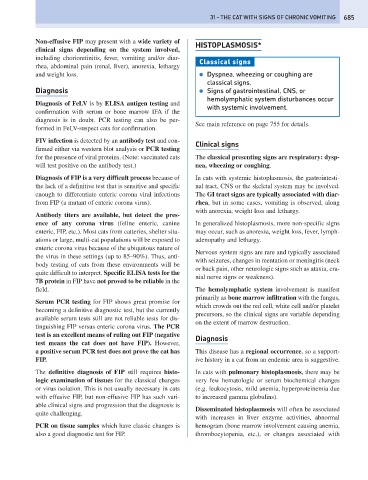Page 693 - Problem-Based Feline Medicine
P. 693
31 – THE CAT WITH SIGNS OF CHRONIC VOMITING 685
Non-effusive FIP may present with a wide variety of
HISTOPLASMOSIS*
clinical signs depending on the system involved,
including chorioretinitis, fever, vomiting and/or diar-
Classical signs
rhea, abdominal pain (renal, liver), anorexia, lethargy
and weight loss. ● Dyspnea, wheezing or coughing are
classical signs.
Diagnosis ● Signs of gastrointestinal, CNS, or
hemolymphatic system disturbances occur
Diagnosis of FeLV is by ELISA antigen testing and
with systemic involvement.
confirmation with serum or bone marrow IFA if the
diagnosis is in doubt. PCR testing can also be per-
See main reference on page 755 for details.
formed in FeLV-suspect cats for confirmation.
FIV infection is detected by an antibody test and con-
Clinical signs
firmed either via western blot analysis or PCR testing
for the presence of viral proteins. (Note: vaccinated cats The classical presenting signs are respiratory: dysp-
will test positive on the antibody test.) nea, wheezing or coughing.
Diagnosis of FIP is a very difficult process because of In cats with systemic histoplasmosis, the gastrointesti-
the lack of a definitive test that is sensitive and specific nal tract, CNS or the skeletal system may be involved.
enough to differentiate enteric corona viral infections The GI tract signs are typically associated with diar-
from FIP (a mutant of enteric corona virus). rhea, but in some cases, vomiting is observed, along
with anorexia, weight loss and lethargy.
Antibody titers are available, but detect the pres-
ence of any corona virus (feline enteric, canine In generalized histoplasmosis, more non-specific signs
enteric, FIP, etc.). Most cats from catteries, shelter situ- may occur, such as anorexia, weight loss, fever, lymph-
ations or large, multi-cat populations will be exposed to adenopathy and lethargy.
enteric corona virus because of the ubiquitous nature of
Nervous system signs are rare and typically associated
the virus in these settings (up to 85–90%). Thus, anti-
with seizures, changes in mentation or meningitis (neck
body testing of cats from these environments will be
or back pain, other neurologic signs such as ataxia, cra-
quite difficult to interpret. Specific ELISA tests for the
nial nerve signs or weakness).
7B protein in FIP have not proved to be reliable in the
field. The hemolymphatic system involvement is manifest
primarily as bone marrow infiltration with the fungus,
Serum PCR testing for FIP shows great promise for
which crowds out the red cell, white cell and/or platelet
becoming a definitive diagnostic test, but the currently
precursors, so the clinical signs are variable depending
available serum tests still are not reliable tests for dis-
on the extent of marrow destruction.
tinguishing FIP versus enteric corona virus. The PCR
test is an excellent means of ruling out FIP (negative
Diagnosis
test means the cat does not have FIP). However,
a positive serum PCR test does not prove the cat has This disease has a regional occurrence, so a support-
FIP. ive history in a cat from an endemic area is suggestive.
The definitive diagnosis of FIP still requires histo- In cats with pulmonary histoplasmosis, there may be
logic examination of tissues for the classical changes very few hematologic or serum biochemical changes
or virus isolation. This is not usually necessary in cats (e.g. leukocytosis, mild anemia, hyperproteinemia due
with effusive FIP, but non-effusive FIP has such vari- to increased gamma globulins).
able clinical signs and progression that the diagnosis is
Disseminated histoplasmosis will often be associated
quite challenging.
with increases in liver enzyme activities, abnormal
PCR on tissue samples which have classic changes is hemogram (bone marrow involvement causing anemia,
also a good diagnostic test for FIP. thrombocytopenia, etc.), or changes associated with

